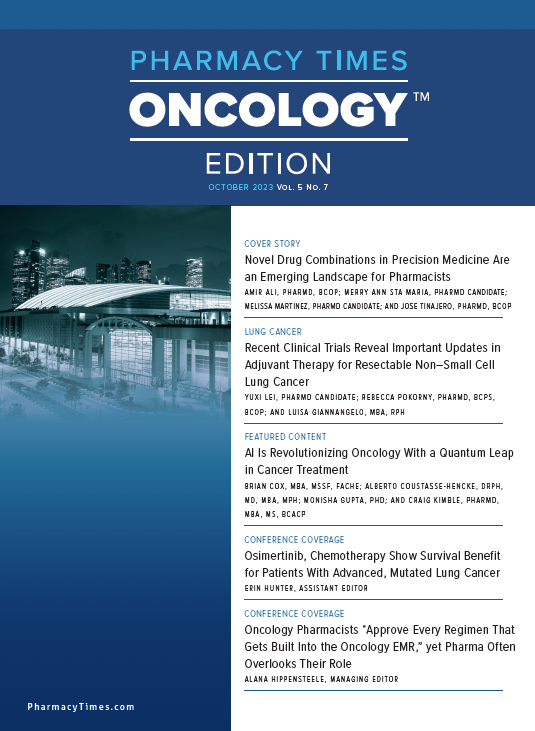Publication
Article
Pharmacy Practice in Focus: Oncology
Novel Drug Combinations in Precision Medicine Are an Emerging Landscape for Pharmacists
Author(s):
A single-center experience at a tertiary medical center precision medicine clinic provides insight.
Precision medicine is the science of individualizing treatment based on genomic alterations of a patient’s cancer. Ultimately, one of the main challenges of personalized medicine is dosing, as there are limited clinical data surrounding novel combinations. A recent prospective, open-label clinical trial (NCT02534675) administered off-label targeted therapies and immunotherapies to patients with advanced cancer based on molecular testing, which resulted in a 45% response rate.1,2 With more than 300 oncologic drugs currently approved by the FDA, data show there are close to 4500 unique 2-drug combinations and 4.5 million unique 3-drug combinations possible, making the type of drug selection and dosing required in precision medicine a rather complicated endeavor.
Image Credit: Fabrizio - stock.adobe.com

In a retrospective study conducted by Nikanjam and Tinajero et al, the investigators included patients at Moores Cancer Center at the University of California San Diego (UCSD) to receive novel oncology drug combinations to treat advanced or metastatic cancer between December 2011 and July 2018. The study aims to validate the previously published set of rules on combination therapy dosing with data from the precision medicine practice at Moores Cancer Center at UCSD.3-6 Novel oncology drug combinations were defined as oncology drug combinations that include trametinib (Mekinist; Novartis), palbociclib (Ibrance; Pfizer Inc), or everolimus as part of oncology drug combinations that are not FDA approved or standard of care. The analysis included patients from the PREDICT study (NCT02478931), which included more than 6000 patients with advanced solid tumors.7
During the PREDICT study, the safe and tolerable combination dose was defined as the dose of a single agent used in a novel combination that was tolerated for at least 1 month with no clinically significant serious adverse events (AEs; eg, hospitalization, dose reduction, dose interruption, discontinuation of treatment, or grade 3 or higher severity).8 If no safe and tolerable dose was found, the lowest dose of the treatment administered was used for the summary statistics.
In PREDICT, patients excluded from data analysis included those who received therapy for less than 1 month, those without drug-related AEs, and those who did not have clinically documented tolerability on therapy. In addition, patients receiving trametinib, palbociclib, or everolimus in standard combinations (eg, dabrafenib [Tafinlar; Novartis] plus trametinib, everolimus plus fulvestrant [Faslodex; AstraZeneca], everolimus plus letrozole [Femara; Novartis], palbociclib plus letrozole) were excluded.
Of the 160 adult patients with advanced or metastatic solid tumors, 71 patients received trametinib, 48 received everolimus, and 41 received palbociclib. Further, most patients reached a safe, tolerable dose, with a few not requiring dose adjustments even though a safe, tolerable dose was not found. Of patients who reached a safe, tolerable dose, 76% were treated with trametinib, 88% were treated with everolimus, and 73% were treated with palbociclib. Of patients who reached a safe, tolerable dose and experienced clinically significant AEs, 22% were treated with trametinib, 52% with everolimus, and 60% with palbociclib. Patients in the trametinib treatment arm who achieved a safe and tolerable dose most commonly reported AEs such as rash, fatigue, and diarrhea. In the everolimus arm, the most common AEs in patients who achieved a safe and tolerable dose were mucositis, gastrointestinal symptoms, infection, and thrombocytopenia. In the palbociclib group, fatigue, anemia, thrombocytopenia, and neutropenia were the most frequent AEs.1
When assessing the use of trametinib, everolimus, and palbociclib as part of novel combinations with other agents, palbociclib achieved the most safe and tolerable doses (73%), whereas everolimus and trametinib achieved the least (48% and 61%, respectively). In combination treatments, trametinib was added to 1 (39% of combinations) or 2 (41% of combinations) other agents, everolimus was added to 1 (69% of combinations) other agent, and palbociclib was added to 1 (49% of combinations) other agent. When these agents were used in combination, most patients achieved a safe and tolerable dose without requiring dose adjustments.1
The results of this retrospective analysis demonstrate how assessing safe and tolerable doses is feasible in a precision medicine approach. However, neither this study nor prior studies could support the use of everolimus in combination with trametinib, even with reduced doses.
How This Impacts Pharmacists
Oncology pharmacists are an integral part of the oncology care team. They actively participate in all aspects of cancer care, from ensuring proper dosing of oncologic drugs to monitoring their safety and efficacy. With the advent of recent advancements in molecular testing and targeted approaches to cancer therapy, the role of a pharmacist is expanding to include a clinical review of novel drug combinations to ensure therapeutic appropriateness and safety.9 Through pharmacists’ specialized knowledge about pharmacokinetics and pharmacodynamics, they can help maximize the benefits of drug therapy while attempting to decrease its toxicities.
Multiple studies have been published regarding the utilization of clinical pharmacists in subspecialty roles.10,11 One study evaluating neuro-oncology clinical time utilization for medication management found that during the 14-day data collection period, there were 338 different pharmacist-based interventions, 31 of which were medication reviews for potential drug-drug interactions.11 The pilot study highlighted opportunities for best practices and optimal time utilization in neuro-oncology clinics. Although most of the pharmacists’ time was spent on patient care activities, including clinical review and medication drug monitoring, they also helped with practice site development tasks, including developing order sets and drafting protocols and documents. Although the utilization of a clinical pharmacy specialist in ambulatory care clinics has been increasing in the past decade, the development of targeted and immune-based therapies reinforces the need for pharmacists in these practices. Further, expanding roles for clinical pharmacists in oncology clinics improves not only clinic operations but also patient care.
How Pharmacists Can Play a Role in the Clinic
The role of oncology pharmacists continues to evolve in areas such as stem cell transplant, hematology, and precision medicine.12 Pharmacists can assist in providing evidence-based care through their clinical knowledge, literature evaluation skills, therapeutic optimization, and understanding the complexity of an agent’s mechanism of action. Additionally, pharmacists play a critical role in mitigating poor adherence, assessing additive AEs of combination therapies, managing treatment strategies for patients with a history of immunotherapy treatments, and improving health care literacy among patients by helping them understand their medication regimens and discussing potential AEs.13
Studies have demonstrated that pharmacists’ increased involvement in advancing the efforts of precision medicine in oncology has a direct impact on patient care through their ability to guide patient-specific treatments and procurement of medications for off-label use. Further, integration of a pharmacist into an oncology precision medicine program (PMP) can facilitate medication acquisition assistance, identify candidate patients, and improve patient education on the understanding of their condition, genomic testing, and precision therapy. The inclusion of pharmacists also provided direct consultation to the inter-professional PMP team through patient-specific workups and case presentations. With only a few PMPs in the United States, oncology pharmacists have had a strong presence in leadership roles in these PMPs as primary investigators in clinical studies and interpreters of genomic sequencing information, as well as through recommending targeted therapies.14
As precision medicine revolutionizes cancer therapy and patient outcomes, oncology pharmacists should seek integration into PMPs and continue to augment their knowledge of therapies for mutation-specific treatment. Advancements in precision medicine continue to expand the role of pharmacists while revealing gaps in pharmacy education. The shift in cytotoxic therapy to targeted medicine has introduced an exciting area of pharmacy practice that further enhances the role of clinical pharmacists in an inter-professional team.
References
1. Nikanjam M, Tinajero J, McGann M, et al. Dosing of 3 targeted agents in novel drug combinations used at the Precision Medicine Clinic of the University of California San Diego. J Hematol Oncol Pharm. 2023;13(1):19-25.
2. Study of molecular profile-related evidence to determine individualized therapy for advanced or poor prognosis cancers (I-PREDICT). ClinicalTrials.gov. Updated March 29, 2023. Accessed July 16, 2023. https://clinicaltrials.gov/ct2/show/NCT02534675
3. Nikanjam M, Liu S, Kurzrock R. Dosing targeted and cytotoxic two-drug combinations: lessons learned from analysis of 24,326 patients reported 2010 through 2013. Int J Cancer. 2016;139(9):2135-2141. doi:10.1002/ijc.30262
4. Nikanjam M, Liu S, Yang J, Kurzrock R. Dosing three-drug combinations that include targeted anti-cancer agents: analysis of 37,763 patients. Oncologist. 2017;22(5):576-584. doi:10.1634/theoncologist.2016-0357
5. Nikanjam M, Patel H, Kurzrock R. Dosing immunotherapy combinations: analysis of 3,526 patients for toxicity and response patterns. Oncoimmunology. 2017;6(8):e1338997. doi:10.1080/2162402X.2017.1338997
6. Liu S, Nikanjam M, Kurzrock R. Dosing de novo combinations of two targeted drugs: towards a customized precision medicine approach to advanced cancers. Oncotarget. 2016;7(10):11310-11320. doi:10.18632/oncotarget.7023
7. Study of personalized cancer therapy to determine response and toxicity (UCSD_PREDICT). ClinicalTrials.gov. Updated April 5, 2021. Accessed January 16, 2023. https://clinicaltrials.gov/ct2/show/NCT02478931
8. Holle LM, Segal EM, Jeffers KD. The expanding role of the oncology pharmacist. Pharmacy (Basel). 2020;8(3):130. doi:10.3390/pharmacy8030130
9. Common terminology criteria for adverse events (CTCAE): version 5.0. US Department of Health and Human Services. November 27, 2017. Accessed January 20, 2023. https://ctep.cancer.gov/protocoldevelopment/electronic_applications/docs/ctcae_v5_quick_reference_5x7.pdf
10. Wheler J, Lee JJ, Kurzrock R. Unique molecular landscapes in cancer: implications for individualized, curated drug combinations. Cancer Res. 2014;74(24):7181-7184. doi:10.1158/0008-5472.CAN-14-2329
11. Arnall JR, Petro R, Patel JN, Kennedy L. A clinical pharmacy pilot within a precision medicine program for cancer patients and review of related pharmacist clinical practice. J Oncol Pharm Pract. 2019;25(1):179-186. doi:10.1177/1078155217738324
12. Lee GW, Mathur AD, Andrick BJ, Leese E, Zally D, Gatson NTN. Pharmacist value added to neuro-oncology subspecialty clinics: a pilot study uncovers opportunities for best practices and optimal time utilization. J Oncol Pharm Pract. 2020;26(8):1937-1941. doi:10.1177/1078155220957738
13. Seung AH, Palatine J, Merten J. Oncology pharmacists bring value and contribute to cancer care. Pharmacy Times. February 21, 2023. Accessed July 16, 2023. https://www.pharmacytimes.com/viewoncology-pharmacists-bring-value-and-contribute-to-cancer-care
14. Walko C, Kiel PJ, Kolesar J. Precision medicine in oncology: new practice models and roles for oncology pharmacists. Am J Health Syst Pharm. 2016;73(23):1935-1942. doi:10.2146/ajhp160211
About the Authors
Amir Ali, PharmD, BCOP, is a clinical pharmacist specialist at the University of Southern California (USC) Norris Comprehensive Cancer Center and an adjunct assistant professor of pharmacy practice at USC Alfred E. Mann School of Pharmacy and Pharmaceutical Sciences in Los Angeles.
Merry Ann Sta Maria is a class of 2024 PharmD candidate at the University of Southern California Alfred E. Mann School of Pharmacy and Pharmaceutical Sciences in Los Angeles.
Melissa Martinez is a class of 2024 PharmD candidate at the University of Southern California Alfred E. Mann School of Pharmacy and Pharmaceutical Sciences in Los Angeles.
Jose Tinajero, PharmD, BCOP, is a clinical pharmacist specialist at the City of Hope Medical Center in Duarte, California, and his areas of specialization include cellular therapies, hematologic malignancies, and hematopoietic stem cell transplantation.

Newsletter
Stay informed on drug updates, treatment guidelines, and pharmacy practice trends—subscribe to Pharmacy Times for weekly clinical insights.





